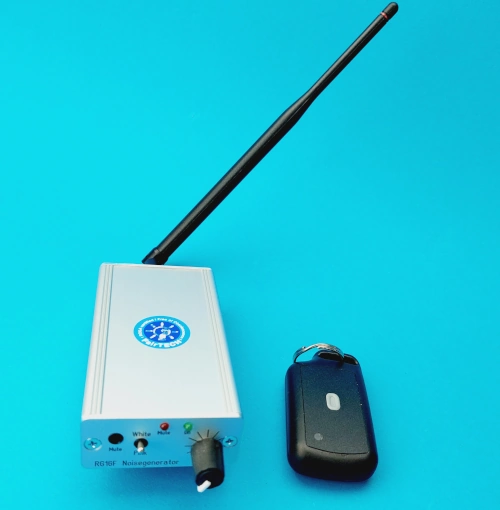Noise Generator
Digital white and pink noise generation
With remote control hand-held transmitter

- Price: 1650 €
RG16F
The RG16 and RG16F noise generators have been specially developed for use in building acoustics and are very handy and lightweight. They generate white and pink noise. The RG16F noise generator can be switched using the hand-held radio transmitter.
If the hand-held radio transmitter is actuated, the output is muted and the red LED indicates this. The antennas are connected via an SMA socket on the front of the RG16F. The manual stop button is connected via a 3.5mm mono jack plug.
Functions
- Digital noise generator
- White and pink noise
- Battery operation
- RG16F With remote control hand-held transmitter
Areas of application
- Building acoustics measurements
- Electroacoustic measurements
The noise generators RG16 and RG16F were developed particularly for employment in architectural acoustics and are very handy and easy. They produce white and pink noise.
The noise generator RG16F can be switched with the wireless remote control. If the wireless remote control is operated, then the exit is mutely switched, and the red LED indicates this.
The SMA socket on the front side of the RG16F is used as antenna socket or manual stop socket. Here also a tracer can be attached over a 3,5mm mono jack plug instead of the antenna.
The noise generators RG16 / RG16F use as noise source a 31-stepped multiple regenerate digital shift
register.
This signal is simply pseudo-stochastic, like all sources using this method. So, the signal is repeated after a while. However, due to the length of the register, this does not happen until a few hours. So, in practice you get a noise with white frequency spectrum.
The crest factor (relationship between peak magnitude and rms-value) is initially 1, because a rectangular signal with stochastic variable period is generated. Only with frequency band limitation or filtering do the crest factor rise more than 1.
White noise is used preferentially when filters with constant absolute bandwidth (FFT) are used for measurement, because the noise of this type of filter supplies the same energy for each filter.
With acoustic measurements filters with constant relative bandwidth are mostly used, whose bandwidth and so also the energy of white noise rises with the center frequency linearly.
To get here also the same energy in each filter, the noise spectrum must be shaped to decrease the energy density with the frequency linearly (pink noise).
Such a filter should have a 3 dB/Octave decreasing frequency response. But in practice this can only be realized approximately for a given frequency range.
The filter, which is used in RG16 /RG16F, is optimized for an acoustic range of 20Hz – 20 kHz.